Photo
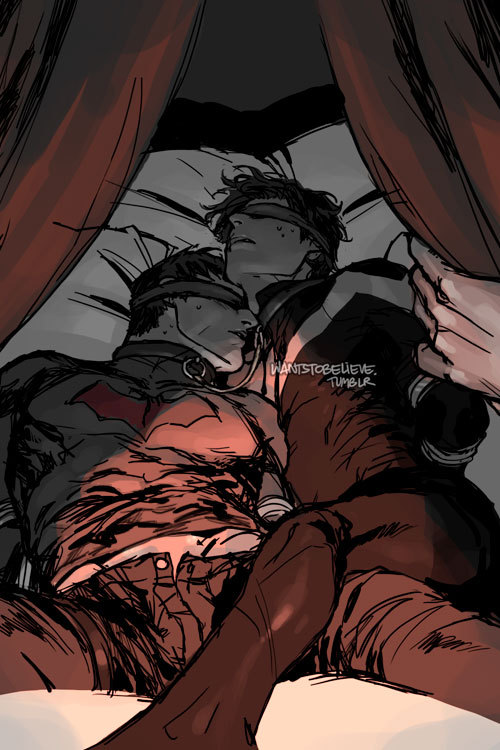
[♔] - “Congratulations on your winning bid, sir.”
(jaydickweek day 3 - restraints. microdrabble with implied sidepairing(s?) below)
Keep reading
8K notes
·
View notes
Text
Love love love characters that present themselves as emotionally open social butterflies but the more you see of them the more obvious it is that they’re the most closed off fuckers in the story. Sure, they want to help you with your personal problems and messy emotions, but if you turn that shit back on them, they’ll shut down or deflect every time. Why are you sticking your nose in their business anyway? It’s not like it matters. They’re not a person, they’re just a role being played. They’re the guy who fixes things and saves people. Please ignore the man behind the mask, he’s fine. Everything’s fine.
91K notes
·
View notes
Text
Critical Ignoring as a Core Competence for Digital Citizens, i.e. “choosing what to ignore, learning how to resist low-quality and misleading but cognitively attractive information, and deciding where to invest one’s limited attentional capacities”.
4K notes
·
View notes
Photo

Rabbits between the staves. Cambrai BM 125-128, c. 1540-50
59K notes
·
View notes
Text

tweet
Something like this would be so colossally helpful. I'm sick and tired of trying to research specific clothing from any given culture and being met with either racist stereotypical costumes worn by yt people or ai generated garbage nonsense, and trying to be hyper specific with searches yields fuck all. Like I generally just cannot trust the legitimacy of most search results at this point. It's extremely frustrating. If there are good resources for this then they're buried deep under all the other bullshit, and idk where to start looking.
148K notes
·
View notes
Text
tim drake's rules brain
I did promise I'd use this account for long form analysis of Batman characters' psychological problems. Something I was talking about on twitter the other day was that to me, one of Tim's primary drivers is his sense of duty -- his need to figure out the correct action and take it. This comes out either in family/social obligations ("I have to quit Robin because my dad said so and he's my dad") or in broader obligations he takes on ("I have to become Robin because Batman needs someone, and nobody else is doing it").
This trait of his is super compelling to me because it's both a strength and something that backfires on Tim constantly -- it's a big source of crunch. On twitter I called him the world's worst utilitarian: he will identify a need and then do pretty much anything short of murder to fill it, even if it tramples over things like his happiness or other people's boundaries.
It's pretty popular in fandom right now to frame his origins like: Tim figures out Batman's identity young, then spends years running around Gotham at night taking photos of Batman and Robin. This is fine!! This is a fine story! Have fun!!
But to me the compelling thing about his intro in A Lonely Place of Dying is that it goes more like: Tim figures out Batman's identity young, and doesn't do anything with this other than keep up with Batman news. While at boarding school he see Batman go apeshit when Jason dies, decides he has to fix this, and during his next week off from school he goes to Gotham and stalks Batman, Nightwing, and Starfire to figure out what's up, makes a plea to Nightwing to come home (without ever telling Nightwing his name because that's not relevant to the task!), and then finally takes on Robin because someone has to do it and he's the closest candidate (while firmly believing he's just a temp substitute!).
The compelling thing is how fast he goes from nondescript eighth-grader to stalker to Robin as soon as he convinces himself he has to do it.
And he does this constantly. My boy sees the world through the lens of rules/obligations/correct actions.
Like I said above, he quits Robin when his dad tells him to, because he needs to respect his dad.
He learns to skateboard (and builds a rocket-powered skateboard) because his dad sells his car and he needs to find a way to get around. Is he a 1990s teenager who just wants to skateboard? Yes. But he has to find a way to make it an obligation.
His conflict in Young Justice 98 is a conflict of obligations! Batman told him he isn't allowed to tell anyone his identity, while his YJ teammates can't trust him because he won't share his identity. Tim repeatedly asks Batman for permission and is bitter about getting a negative response, but won't go behind his back: he needs to respect his duty. (He's super relieved and gleeful when a villain reveals his identity to the team -- it's out of his hands! oh no! what a pity!!)
When Bruce tells Stephanie his identity he's furious at Bruce for the breach of trust and giving Steph more info than he wants her to have, but also specifically for breaking their contract -- they have an agreement and they need to follow it. Tim follows it! Why isn't Bruce??
Throughout the 90s, Bruce's failures to Tim are framed by Tim basically as breaches of contract. It isn't "this isn't a just or kind way to behave to someone in your life," it's "we had a deal and you need to follow it." Batman's 16th birthday present to Tim is two weeks of psychological torture in the form of a fake time-travel mystery; when Tim figures out it was a test, he's furious Bruce for the breach of trust and quits, but he returns within a week because 1) all his friends are capes and he'll never see them again as a civilian and 2) someone needs to protect Gotham. (His loneliness/desire for companionship is another Big Tim Trait imo. but that's another over-long tumblr post.)
Battle for the Cowl is not a good arc but I do think it's significant that in it Tim is the one who lets Jason out of prison, because in a way they're family, and you need to give family a second chance. That's the deal with families.
There's a point in 90s Robin where Tim builds himself a mobile computer system and teaches himself to type on a one-handed keyboard because he needs to find a way to look stuff up in the field without Oracle. Like the skateboard thing... he doesn't actually talk about just wanting to be a keyboard guy. Lots of people have fun building keyboards as a hobby, Tim. No. He has to invent an obligation about it.
[Tim Drake Fake Uncle Scam Arc Goes Here]
Red Robin is entirely about Tim deciding he needs to achieve a series of increasingly ridiculous goals. He needs to prove Bruce is alive. He needs to keep Wayne Enterprises solvent. He needs to take out the League of Assassins. If this ends with him as 1) the boy-king CEO of Wayne Enterprises 2) missing a spleen 3) obliged to pretend to have two broken legs for a year 4) the target of multiple real and fake assassination attempts 5) out of contact and on the outs with his family for months he'll do it. because he needs to.
As a counterpoint to the above, if he doesn't feel an obligation he'll do absolutely whatever. He lies to Batman constantly if it isn't something he feels Batman needs to know.
I could keep going. I'm forcing myself to stop here. This is too long.
Tim isn't "the smart Robin." Tim is the Robin who has weaponized the feeling of I Just Gotta so hard that he can use it to take down Ra's al Ghul. And watching himself either get trapped in an obligation or make one up so he can do what he wanted in the first place is part of what makes him so interesting to me!! ok thanks.
1K notes
·
View notes
Text

i know we joke about cis artists having the weirdest sense of anatomy, but also even when the anatomy is fine, no one seems to want to draw women doing normal things
170K notes
·
View notes
Text
Hey kid, look at me.
I want you to T-pose. Turn your right thumb up and your left thumb doen and look at your right thumb. Move your arms up and down a bit until you feel a nerve running from your armpit to your palm. Now turn your right thumb down and your left thumb up, and look at your left thumb. Keep your chest facing forward and your shoulders back. Move your arms again until you feel that nerve again. Keep alternating between these two for a minute, or look at each thumb thirty times each.
Now sit down. Put your left hand firmly under your left buttock, palm down. Keep your shoulders back and put your right hand over the crown of your head, very gently pulling it to the right. Do this for thirty seconds, then do it again but with your right hand under your right buttock.
These are stretches for the nerves in your arms, and are very good for people who sit behind a computer a lot, or fibre artists, or you name it. Do them daily. They will hurt in the beginning, but keep doing them, even after the pain has gone, or it will return and you'll have to start all over.
44K notes
·
View notes
Text
Ref Recs for Whump Writers
Violence: A Writer’s Guide: This is not about writing technique. It is an introduction to the world of violence. To the parts that people don’t understand. The parts that books and movies get wrong. Not just the mechanics, but how people who live in a violent world think and feel about what they do and what they see done.
Hurting Your Characters: HURTING YOUR CHARACTERS discusses the immediate effect of trauma on the body, its physiologic response, including the types of nerve fibers and the sensations they convey, and how injuries feel to the character. This book also presents a simplified overview of the expected recovery times for the injuries discussed in young, otherwise healthy individuals.
Body Trauma: A writer’s guide to wounds and injuries. Body Trauma explains what happens to body organs and bones maimed by accident or intent and the small window of opportunity for emergency treatment. Research what happens in a hospital operating room and the personnel who initiate treatment. Use these facts to bring added realism to your stories and novels.
10 B.S. Medical Tropes that Need to Die TODAY…and What to Do Instead: Written by a paramedic and writer with a decade of experience, 10 BS Medical Tropes covers exactly that: clichéd and inaccurate tropes that not only ruin books, they have the potential to hurt real people in the real world.
Maim Your Characters: How Injuries Work in Fiction: Increase Realism. Raise the Stakes. Tell Better Stories. Maim Your Characters is the definitive guide to using wounds and injuries to their greatest effect in your story. Learn not only the six critical parts of an injury plot, but more importantly, how to make sure that the injury you’re inflicting matters.
Blood on the Page: This handy resource is a must-have guide for writers whose characters live on the edge of danger. If you like easy-to-follow tools, expert opinions from someone with firsthand knowledge, and you don’t mind a bit of fictional bodily harm, then you’ll love Samantha Keel’s invaluable handbook
28K notes
·
View notes
Text
how does being punched in the face feel like
117K notes
·
View notes
Text
I'm not kidding when I say worldbuilding is extremely easy and fun, you can make easily all sorts of new fantasy worlds on like half an hour, follow this guide:
take a rectangle, draw a line through the middle, that's your equator, draw another two lines south and north, those are your tropics, draw another two lines further north (you can see a real world map to guide yourself), those are your arctic/antarctic circles
Draw continents, any shape you want, it's better to combine large soft blobs (like Africa or South America) with coastlines full of peninsulas and islands (like Europe or South Asia). Draw some island chains in between where you feel it's appropiate. Some inland seas like the Mediterranean are good too.
Decide where you will place mountain ranges. In real life, they are where oceanic-continental plates (Andes) or continental-continental plates (Himalayas, Alps), collide. These are very important.
Place rivers, just the most important ones. The places where you place big river systems are gonna be big plains.
Now, the fun part. With your first step, you've already decided where arctic, temperate, and tropical climates are there. You can mark it as letters in your map. Mountain ranges, of course, are colder.
Here's the tricky part: vegetation: vegetation mostly follows precipitation, and precipitation is mostly decided by altitude and distance from the ocean. The interior of your continents should be dry with plains and deserts; the coasts should be rainy with forests and plains. But remember, if you have a mountain range, that's a rain shadow! Picture the wind coming from the ocean with rain, and it should get less rainy when it "clashes" with a mountain range, with the other side a desert.
Deserts are tricky to place, but as a quick cheat, you can place them in your tropic lines. They can even border oceans: see Australia and the Kalahari.
WHEN IN DOUBT, LOOK AT SIMILAR AREAS ON A REAL WORLD VEGETATION/CLIMATE MAP. THIS IS WHY DRAWING THE EQUATOR AND THE TROPICS IS SO IMPORTANT AND SHOULD BE YOUR FIRST STEP ALWAYS.
Now you already have a quick and dirty vegetation map, you're halfway there! Don't worry if there are some doubtful areas, real world geography can be weird.
Now for the REAL fun stuff (if you aren't having fun already, I sure am): making civilizations!
You have to decide center of origins for your domesticated crops and animals. Basically, every early civilization had its own "package" of staple crops and animals that are still used today.
With this, you can decide:
the primary civilizations of your world
roughly how different animals and vegetation are distributed, if you want an Earth-like world (for an quicker method, you can apply the biogeographical realms to your own continents as you wish)
A quick cheat sheet of centers of origin, what they have, and where you can place them:
(this is just a quick thing, do read the article it's so much better)
Middle Eastern: wheat, barley, cows, sheep, goats. Place them in a dry area with lots of rivers (the Fertile Crescent!)
East Asia: rice, soybean, oranges, pigs, horses. Place it in a rainy temperate area bordering the tropics.
Mesoamerica: Corn, beans, pumpkin, chilli, tomato. Place it in a dry area near the tropics.
Andes: Potato, quinoa, llamas. Place it in a mountain range.
Tropical South America: manioc, peanuts, pineapple. In the tropics.
Tropical Asia: Rice, banana, sugar cane, beans. In the tropics, again.
or, just straight up use this fucking map, it's so much better:
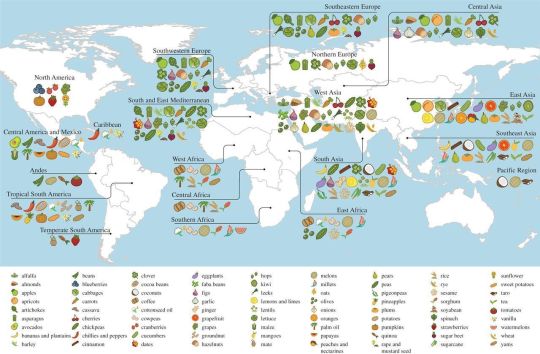
You can mix and match the crops, animals, and such as you wish, and you should definitively read the wiki page on center of origins and see some other less known crops.
If you have non-human civilizations, of course they'll have different packages. Carnivore or subterranean civilizations might be very different. But at this point, your imagination should be flying already and I don't have to hold your hand here.
Now, you have a rough map of your world at the dawn of agriculture! Congratulations! Depending on the historical period you're setting your world, you can start to draw countries and civilizations. This is where it gets complicated again. I might have to make a part two... But just with this, you already have a new world to use as you wish.
I'll make a worked example later to show you how easy it is if you don't believe me.
2K notes
·
View notes
Text
Dick Grayson Comics Timeline
Alright upon request (and after much compiling) I’m finally done with this pre New 52, fully referenced, Dick Grayson timeline @chestnutcats. It’s super long, so a short version here:
Parents die; becomes Bruce’s ward & Robin. Age: somewhere from 8-13, but usually on the younger end of that scale
Forms Teen Titans. Age: …teen?
(Barbara becomes Batgirl. Could be swapped with the above.)
Teen Titans split up. Age: <=18
Goes to college. Drops out of college. Age: college.
New Teen Titans form in NYC. Age: 19ish
Fired as Robin. No longer taking to Bruce. Fully living in NYC with the Titans, if he wasn’t already. Becomes Nightwing. (Jason becomes Robin.) Age: 19; Jason is 12
(Barbara shot. Jason killed. Tim becomes Robin. Talking to Bruce again. Age: 19 + however long Jason was Robin, so maybe 22. Tim is 13. Does Tim’s backstory make sense if he’s 9 years younger than Dick? Probably not, but writers don’t do math!)
New Teen Titans split up. Age: early 20s
Chillin’ as Nightwing, location unknown
Briefly Batman, with Robin Tim. Age: 20s, and age no longer matters. Tim is 14 or maybe 15, and the only hope we have of keeping the years straight.
Chillin’ as Nightwing, pt 2
Moves to Bludhaven. Helps out when things ultra-suck in Gotham.
Titans re-form.
(Gotham ultra-sucks for a while because Earthquakes and Government. Cass becomes Batgirl.)
Officially adopted by Bruce.
Titans split up. Reluctantly joins the Outsiders.
Everything Is Very Bad. Age: Tim is 16 by now, but comic book math is whatever you want it to be, and you needn’t be beholden to things like “numbers.” Dick is in his 20s, as he will be forever.
(Tim has to quit Robin; Steph becomes Robin; Steph fired; Tim Robin again; Steph “dies”.)
Jason returns, and then vanishes again.
The universe kind of explodes and then un-explodes. Bludhaven explodes and remains exploded. (Age: Tim is still 16, but eons have passed.)
Bruce & Dick & Tim go travelling for a year because fuck it.
Moves to NYC again. (Tim adopted. Damian first introduced. Age: Tim logically must be 17, and Dick is logically in his mid 20s, but logic never helped anyone.)
Leaves Outsiders.
Titans re-re-form.
(Steph returns, revealed to be not dead. Cass adopted.)
Leaves Titans.
Universe explodes again. Bruce (apparently) dies.
nananananana BATMAN (ft Damian as Robin). Tim off as Red Robin. Stephanie as Batgirl and Cass out of Gotham. Jason causing mayhem. Age: just about the same age Bruce was when he met Dick, and ain’t that a trip
Bruce returns. Dick also stays as Batman. Bat…men.
The long version is under the cut, and by long version, I mean like 20 pages which is…possibly more than you wanted and surely more than you expected, but here we are.
This is half timeline, half reading list. The comics referenced here have occasional notes based on quality, but they’re mostly chosen based on giving you the major points and the best understanding of continuity. This is all firmly pre-flashpoint, because I Do Not Know the new52 or anything beyond and don’t want to.
If anyone reading this wants more detail on any bit of it (whether specific comics and issues, timelines, character relationships, or what have you), or more info on a different character, I am happy to answer questions!!
If read mores don’t work for you, a person seeing this post…I am so sorry and just start scrolling.
Keep reading
249 notes
·
View notes
Text
The Very Basics of Not Killing Your Computer
AVOID HEAT STRESS
If you have a laptop DO NOT use it on a soft surface like a pillow or on a blanket, it’ll block the vents on your computer and make it get really fucking hot inside.
If you have a desktop you gotta open it up and blow out the dust sometimes.
If you are moving your laptop in a bag turn the laptop off. Don’t put it to sleep, don’t just shut the screen, turn it off, because otherwise it’s in the bag generating heat and there’s nowhere for the heat to go in the bag. OFF. Not sleep. OFF.
DO NOT DROP
Okay I know that should be obvious but drop damage to your hard drive is bad bad news. Be as careful as you can to set your computer gently on flat surfaces; don’t leave it hanging out on a bed where it can get knocked off, don’t set it on the roof of your car. And yes, just dropping it a couple inches can kill your hard drive or totally shatter your screen.
DON’T PUT SHIT ON YOUR KEYBOARD
Look I’ve seen four people ruin their laptops because they had a pen on the keyboard and closed the laptop and it fucked up the screen and the keyboard and it sucks so much and you feel awful after it happens because it’s so avoidable just don’t put things on your keyboard and always check that your laptop is clear before you close it.
PROTECT YOUR PORTS ON YOUR LAPTOP
You’ve only got one power jack and a limited number of other inputs on your computer and if they detach from the motherboard you’re fucked. USB ports get damaged because people use them a lot and eventually it weakens the connection and then they just stop working and it sucks. You can get around this with USB ports by using a USB hub to connect things like your keyboard and mouse.
For your power plug you just gotta be careful. Avoid tripping over the cord at all costs, don’t yank the plug out of the computer. It will SUCK VERY MUCH A LOT if you have to buy a new computer because the power port lost contact with the motherboard.
Don’t move your computer with things plugged into it. Take the power cord off before you put your laptop in the bag, take out the USB mouse dongle, do not travel with little nubby bits sticking out of your computer that can easily get caught or get tweaked or snap off inside of the thing.
(I really can’t emphasize enough that most of the “it will cost more than it’s worth to fix this” laptops I see are because of USB ports and power jacks. People don’t seem to know that this isn’t something that can be fixed easily; a broken power jack is a “remove the motherboard and resoldier components” job, not a “plug a new one in in fifteen minutes” job and most computer repair shops aren’t going to solder things for you and if they DO it’s going to be very expensive)
RESTART YOUR SHIT AT LEAST ONCE A MONTH AND JUST LET THE FUCKING UPDATES RUN
You should probably restart more than once a month but whatever. This is actually something that I consider part of reducing heat stress because when your processor is straining to keep up with all the background bullshit that’s running from a program you opened three weeks ago it’s going to use up resources and get hot and look just restart it once in a while.
Also the updates are almost always okay and safe and generally running updates is a good and secure thing to do (though maybe follow a blog dedicated to the OS you run because if there IS a problem with the updates that blog will probably talk about it before the update gets forced on your computer)
ANTIVIRUS BULLSHIT
Yes you should probably be running an antivirus.
Sophos is free and it’s fine. But don’t pay for it - if you’re using Sophos use the free version.
If you’re looking for something paid and a little more comprehensive I recommend ESET - get the cheap version, renewals cost less than the initial purchase, and feel free to get a multi-year version, the credentials follow your email not the computer so if your computer dies before your license expires you can install the license on a new computer.
DO NOT INSTALL NORTON OR MCAFEE THEY ARE EXPENSIVE BULLSHIT. Kaspersky is whatever. It’s less bullshit than Norton or McAfee but not as good as ESET for about the same cost.
If you think you’ve got a virus run the free version of Malwarebytes and get your shit cleaned.
KEEP LIQUIDS THE FUCK AWAY FROM YOUR COMPUTER
Again this should be obvious and yet. But seriously, just make a rule for yourself that drinks aren’t allowed on the same table as your computer and you’ll save yourself a lot of headaches.
PLUG YOUR COMPUTER INTO A UPS
Okay I fucking hate amazon but here’s a thing you should be using, just search the rest of the internet for “surge protector/UPS” and you’ll find something that isn’t from amazon - APC is a solid brand for this.
Basically you want a fat surge protector that has a little bit of a battery backup and you want to plug your computer (desktop OR laptop) into that instead of into the wall. The benefit of this is twofold:
1) if there’s a power surge the UPS will prevent your computer’s power supply from getting fried and possibly frying parts of your motherboard
2) if there’s a power outage and you’re *at* your computer you’ll have enough time to save what you’re working on before your computer loses power (like, you’ll maybe only have a minute or two on a small UPS but that’s still time to hit CTRL+S and keep from losing work)
At a bare, bare minimum your computer should be plugged into a surge protector but NOT directly into the wall.
BACK YOUR SHIT UP
[we interrupt this yelling for me to tell you that Western Digital has apparently released their new My Passport line and I’m obligated to inform you that you can get a 2.5″ USB 3.0 backup drive with FIVE FUCKING TERABYTES OF STORAGE for $130. Or you can get 4TB for $93. Or you can get 1TB for $53. basically what I’m saying is that it is not only cheap computer season it is also cheap hard drive season.]
[also if you’re getting a backup drive get western digital not seagate seagate fucking sucks and has a much higher failure rate]
Uh, okay, anyway - Do an image backup of your computer every once in a while so that if you get infected or your hard drive dies or whatever you can just restore from backup and move on like nothing happened.
HERE’S HOW TO DO AN IMAGE BACKUP.
SAVE YOURSELF THE WEAR AND TEAR
You know what is cheap? USB Keyboards and USB mice. You know what is not cheap? Fixing the touchpad on a laptop or replacing a laptop keyboard.
Get yourself a USB hub, a USB Keyboard and a USB Mouse (wired or wireless, doesn’t matter) and if you’re using your laptop at home plug *that* into your computer.
Also if your keyboard on your laptop breaks it’s fine just to use a USB keyboard instead I promise; if the screen breaks it’s also usually cheaper and easier to get a used or inexpensive monitor than it is to replace the screen. Your laptop is basically just a very small version of whatever bullshit is going on inside a desktop, if the peripherals break but the core components are fine you can just use it like a desktop.
Unless it’s a piece of shit that doesn’t have any USB ports or video out in which case you got ripped off, friend, demand functionality in your devices I’m sorry.
/rant
114K notes
·
View notes
Text
A Workshop for Creating Magical/ Fictional Crystals: A Guide from a Geologist
Hi folks, its me, here to talk about fictional writing again! Today I'm just tackling the idea of magical stones/mana stones by looking at existing minerals today and some neat properties that they have, and how you can apply these things to a fictional world. The goal is mainly to help you if you are stuck trying to come up with a unique magic system, or a unique identification/characteristic of your mineral.
First Things First: Mineral Shapes

I am exhausted, petered out, down-right fatigued by seeing every mineral depicted with having the crystal structure of calcite and quartz. There are soooooo many cooler, more interesting crystal structures, don't you think you would stop and take a look at a perfect cube in nature? It is completely unsettling.
Second: Color
Color within minerals can either be really important, or not important at all! It is your choice to decide if color is going to be something that means something to your mineral. But what are some times when the color is important? Well.... there are some elements that are called chromophores, this classification just indicates that these elements, when present, will determine the color of whatever they are in. So, if you wanted to treat mana like a chromophore, you could say, "Oh everything that contains mana turns green!" This could mean that regardless of the mineral, if that mineral is a specific color, it means it contains mana. This concept is exciting because you can just stop here and use minerals that already exist! You can also use it as an indicator for a magical ore! Chromophores are typically metals, so if you are making a new metal weapon, making the ore of that metal a unique color would make a lot of sense!
However, your mineral can also just be every color of the rainbow like quartz and perhaps that's what makes identifying your mana stones elusive and create an illusion of scarcity that your character can solve.

There are other things that can change the colors of minerals, like radiation damage, and electron exchange, but I think that is beyond what would be helpful! So lets talk about some unique color properties that happen in nature that seem magical in the first place! Maybe you don't need to design a mana stone, but you want a unique gemstone that only the royal family passes down or something (IDK).
The first one is the alexandrite effect! This is where a mineral can change color in natural light vs. incandescent light. (the mineral itself is not changing, but the lights contain different amounts of different colors that then get absorbed by the stone). Even if you don't use electricity in your fictional world, you could have the colors change in the presence of light magic. This could create fun misunderstandings about what the mineral is reacting to!
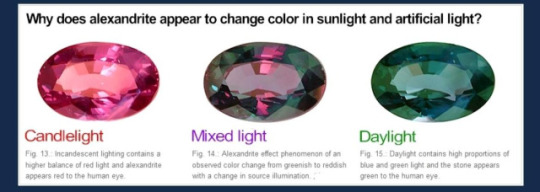
Pleochroism
Pleochroism is something that most minerals have, it is frequently used to help identify minerals in thin sections, however minerals are usually not pleochroic enough for it to be visible to the naked eye! Pleochroism is just a fancy name to describe the change in how light is absorbed based on the angle of the mineral! So if you scroll up to the first image where I showed a lot of crystal shapes, most of them have angles where they are longer and shorter! This will effect the way light travels in the crystal. Tanzanite is a popular mineral that does this.

Photochromism
This is when a mineral will change color (in a reversible way) when exposed to UV light (or sunlight), I am not going to go too into the details of why this is happening because it would require me to read some research papers and I just don't feel like it. The mineral that is best known for this is Hackmanite!
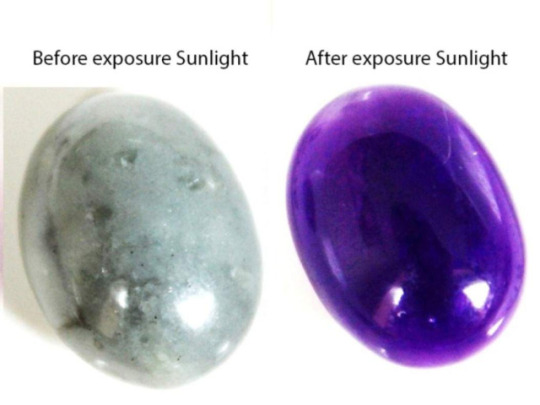
Alright! These are all the really cool color effects that might inspire you or maybe not, but now I am going to talk about how you might find your minerals within a rock!
When I see a lot of magical caves/mines, typically I see them with some variation of a geode honestly, but most minerals are not found like that! Now I am sure most of you guys have seen a geode, so I will not really talk about those, but I will talk briefly about porphyroblasts which is when the mineral grows larger than the minerals around it, this happens in metamorphic minerals!

sorry random stranger, but this is an image of garnets inside a finer-grained rock at gore mountain in New York!
Another way you might find minerals is in a pegmatite! This is when all minerals are really large! This is a formed from really slow crystalizing magma!
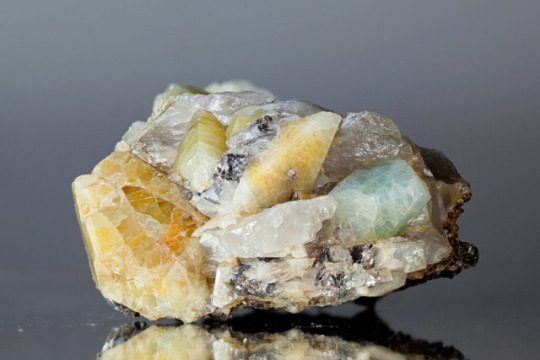
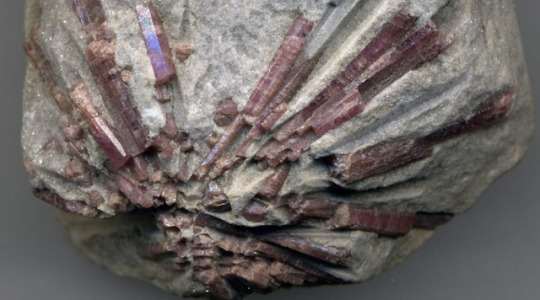
But something else to think about is that your mineral might just be massive, it doesn't have to have distinct crystals, it may be similar to jadeite where small grains grow together which leaves it looking smooth and seamless! A note about all of these is that you would have to mine into the rock to find these, there would not be any natural caves in these rocks! Caves are only ever really formed in limestones and maybe marbles (rocks that react with acid).
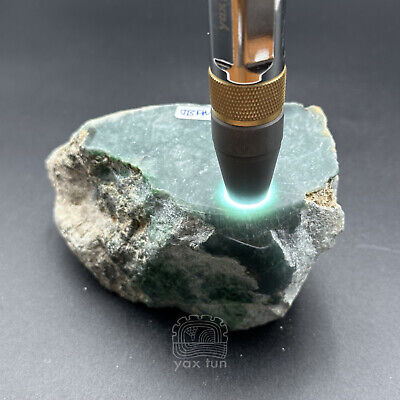
How can your characters identify these minerals?
Typically when you are out in the field you will look to see what type of rocks the minerals are found in (The overall texture of the rock will tell you how it formed). If you know how the rock formed, it will narrow down the amount of minerals you need to think about by quite a bit! Next, you are going to look closely at it and observe its crystal structure, does it have an obvious crystal? if so what is the general shape? If it is broken, how did it break? Did it fracture like glass or did it break along uniform planes. Some minerals have a thing called cleavage (breaks along planes of weakness). If a mineral exhibits this habit, it will again help narrow this down. Next we can look at color. Color can be misleading, because minerals like quartz can be any color imaginable, but minerals like olivine will always be green! The next thing your character can do is test for hardness, minerals all have a specific hardness that can help identify it as well.
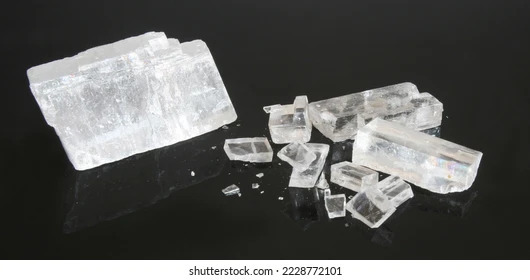
After you go through all of this, your mineral might have some special property! This could be magnetism, fluorescence, reactions to acid, or any of the color changing effects I mentioned above! Other than that, your character can take it back to a lab and do a number of things to identify it, but the most typical thing would be for them to make a thin section (very thin piece of the rock) and observe it under a cross polarized microscope!

On that note folks! I hope this helped in some way in thinking of new magic mineral properties! I have other guides that explore some different fictional worldbuilding issues you might run into, but if you have any topics you would like me to cover please that I haven't mentioned already, let me know!
6K notes
·
View notes
Text
Yay, unsolicited advice time! Or, not really advice, more like miscellaneous tips and tricks, because if there's one thing eight years of martial arts has equipped me to write, it's fight scenes.
.
Fun things to add to a fight scene (hand to hand edition)
It's not uncommon for two people to kick at the same time and smack their shins together, or for one person to block a kick with their shin. This is called a shin lock and it HURTS like a BITCH. You can be limping for the rest of the fight if you do it hard enough.
If your character is mean and short, they can block kicks with the tip of their elbow, which hurts the other guy a lot more and them a lot less
Headbutts are a quick way to give yourself a concussion
If a character has had many concussions, they will be easier to knock out. This is called glass jaw.
Bad places to get hit that aren't the groin: solar plexus, liver, back of the head, side of the thigh (a lot of leg kicks aim for this because if it connects, your opponent will be limping)
Give your character a fighting style. It helps establish their personality and physicality. Are they a grappler? Do they prefer kicks or fighting up close? How well trained are they?
Your scalp bleeds a lot and this can get in your eyes, blinding you
If you get hit in the nose, your eyes water
Adrenaline's a hell of a drug. Most of the time, you're not going to know how badly you've been hurt until after the fact
Even with good technique, it's really easy to break toes and fingers
Blocking hurts, dodging doesn't
.
Just thought these might be useful! If you want a more comprehensive guide or a weapons edition, feel free to ask. If you want, write how your characters fight in the comments!
Have a bitchin day <3
19K notes
·
View notes
Text
I want to write a book called “your character dies in the woods” that details all the pitfalls and dangers of being out on the road & in the wild for people without outdoors/wilderness experience bc I cannot keep reading narratives brush over life threatening conditions like nothing is happening.
I just read a book by one of my favorite authors whose plots are essentially airtight, but the MC was walking on a country road on a cold winter night and she was knocked down and fell into a drainage ditch covered in ice, broke through and got covered in icy mud and water.
Then she had a “miserable” 3 more miles to walk to the inn.
Babes she would not MAKE it to that inn.
142K notes
·
View notes
